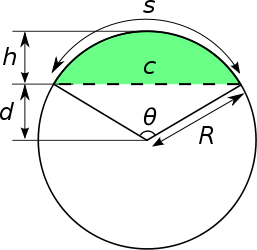For best results in viewing this page, right-click an equation on this page, select Math Settings -> Math Renderer -> HTML-CSS.
Finding the height of a circular segment (the green area in the figure below) given the area is an interesting problem in numerical analysis.
To find the height, it is necessary to find the intermediate variable \(\theta\), which is the angle subtended by the circular segment. The equation to be solved is \[f(\theta):=\theta-\sin(\theta)-\frac{2A}{r^2}=0,\] for \(\theta\). It is a transcendental equation, and therefore not solvable in a closed-form solution. The first thing to mention about this equation is that we are guaranteed a solution, even in the non-physical case that \(A>\pi r^2\). Why is that? We note that \(f(\theta)\) is continuous. If we can show that there are two angles, \(\theta_1\) and \(\theta_2\), with \(\theta_1<\theta_2\), such that \(f(\theta_1)\cdot f(\theta_2)<0,\) then by the Intermediate Value Theorem, there must be a solution in the interval \((\theta_1,\theta_2).\) The derivative
\[\frac{df}{d\theta}=1-\cos(\theta).\]
Since \(-1\le\cos(\theta)\le+1,\) it follows that \(0\le 1-\cos(\theta)\le 2,\) and hence \(f(\theta)\) is monotonic. It turns out that \(f(\theta)\) is strictly monotonic, since the derivative is zero only at isolated single points in the domain: at points \(2\pi k, \; k\) an integer, and the derivative never changes sign. \(f\) being strictly monotonic implies that \(f\) is one-to-one. Since
\[\lim_{\theta\to-\infty}f(\theta)=-\infty\qquad\text{and}\qquad \lim_{\theta\to+\infty}f(\theta)=+\infty,\]
and \(f\) is continuous, it follows that we can find the \(\theta_1, \theta_2\) above that satisfy the conditions. In fact, any angle \(\theta_1<(2A/r^2)-1\) and angle \(\theta_2>(2A/r^2)+1\) will do. So we have shown that a solution exists. This solution must be unique, since \(f\) is one-to-one.
This is valuable information to know, from a numerical analysis perspective, because it means there might well be a stable numerical algorithm to find the root. Unfortunately, \(f'(\theta)=0\) for all \(\theta=2\pi k, \; k\) an integer. Therefore, the Newton-Raphson method is possibly unstable, since it divides by the derivative which could be zero. The secant and regula falsi methods, while possibly converging faster than bisection, do not have the guaranteed convergence rate and stability of bisection. If you can bound the initial interval significantly, the bisection method could give very good accuracy with only a few iterations, and would be more stable than the derivative-based methods. Fortunately, we can bound the solution in an interval of width two by observing: if \(\theta\) is a solution of the above equation, then
\begin{align*}
-1&\le \sin(\theta) \le 1 \quad \implies \\
-1+\frac{2A}{r^2} &\le \sin(\theta)+\frac{2A}{r^2} \le 1+\frac{2A}{r^2} \quad \implies \\
-1+\frac{2A}{r^2} &\le \theta \le 1+\frac{2A}{r^2}.
\end{align*}
Hence, we have that \(\theta\in[-1+2A/r^2 , 1+2A/r^2],\) an interval of width \(2.\) We can actually tell in advance how quickly the bisection method will converge to a true solution with a specified accuracy. If \(n\) is the number of iterations, then
\[n=\frac{\ln(2+2\varepsilon)-\ln(\varepsilon)}{\ln(2)}.\]
Here, \(\varepsilon\) is the accuracy required, and also used to widen the interval just slightly in the unlikely event that the solution occurs precisely at an endpoint. The bisection method here runs extremely quickly - in practice we only need \(17\) or \(18\) iterations to achieve four or five significant figures. So we use the bisection method to find the angle subtended by the ideal circular segment, and then the height of the circular segment is given by
\[h=r-r\cos\left(\frac{\theta}{2}\right).\]
Click the button below to view a native LabVIEW 2015 SP1 implementation of the bisection method for this problem.



